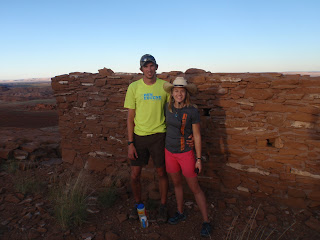When Sara and I decided to hike the Continental Divide Trail we knew it was going to take a lot of planning, but we assumed we would just pick any of a number of guide books, find some maps and plot the route along the trail. Of course we were counting on a few hangups, but not that there are really only two major guidebooks, which both detail different routes and one is not too helpful if you are hiking north. Nor were we aware that the route is not even on most maps and the "official" CDT map is compiled by Jonathon Ley in his spare time and that one of the guide books does not follow Ley's route, rendering that book nearly useless. The factor that has/will present/ed the most difficulty, and what truly sets it apart from the Appalachain Trail and the Pacific Crest Trail, is the trail is only about 70% completed and therefore subject to the map reader's whims.
 |
| Sara enjoying the lack of trail in the Grand Canyon. |
In all of our research we keep finding the mantra, "hike your own hike." Meaning, since there is not an official trail that 100% of people agree on, find what works for you. Hike the speed that works for you. Carry what works for you. Resupply where works for you. Eat however much ice cream works for you. This is great for us because we want an adventure that does not have pressure to see certain things or stop at certain places. At the same time this also left us with very little to go off of in terms of planning.
 |
| Map from Jonathon Ley through CO. Red is suggested route, purple is alternate |
My brother is planning a trip on the PCT and he showed me a bandana that is a map of the trail with all the resupply points along the route. With no bandana map for the CDT, Sara and I were prepared to painstakingly flip through atlas pages to find all the small towns and lodges along the way that might have a mail box. Fortunately for us, the set of maps that Jonathon Ley has put together is absolutely amazing complete with comments and alternate routes drawn in. Additionally, the Yogi Guide Book provides the Ley map number for each resupply point and subject the book mentions, which means we just had to do some math to decide how many miles we want to go between each resupply.
 |
| Section of Wind Rivers |
 |
| Thanksgiving stuffing in the bottom of the Grand Canyon |
Mileage was another thing to consider for us. When my parents did the PCT in the 1980's, they averaged between 13 and 15 miles a day. Originally we figured we could average close to 18 because we have the advantage of lighter gear and having maintained some level of fitness after competing in collegiate athletics. After reading blogs and speaking with previous hikers, however, we realized we could up our projected average. Most people average just over 20 miles a day. Apparently lighter gear makes a big difference. This also made our math much easier. 100 miles equals five days.
Aside from, "hike your own hike," the other big thing we have been told is to be flexible. On start date, on routes, on zero (mileage) days, on everything. This is because on the trail anything can happen, including but not limited to: changes in weather, changes in gear, changes in local's attitudes toward hikers, getting tired, getting lost, and getting found.
 |
| Monarch Pass: the last time Sara and I were in the Rockies |
DISCLAIMER: All of the these dates are tentative and do not account for zero days if/when needed. Count on dates later in the trip being farther off schedule than days early in the trip.
 |
| Zeno will be hiking with us. Want to help us get him around National Parks? |
If you would like to join us for hiking at any point, or simply meet up with us that would be great. We are looking for a few people to help out with Zeno (our dog) as we hike through national parks, since he is not allowed in the backcountry. Please use us as an excuse to plan a summer vacation in the Rockies!
Next week: Gear
Forrest




